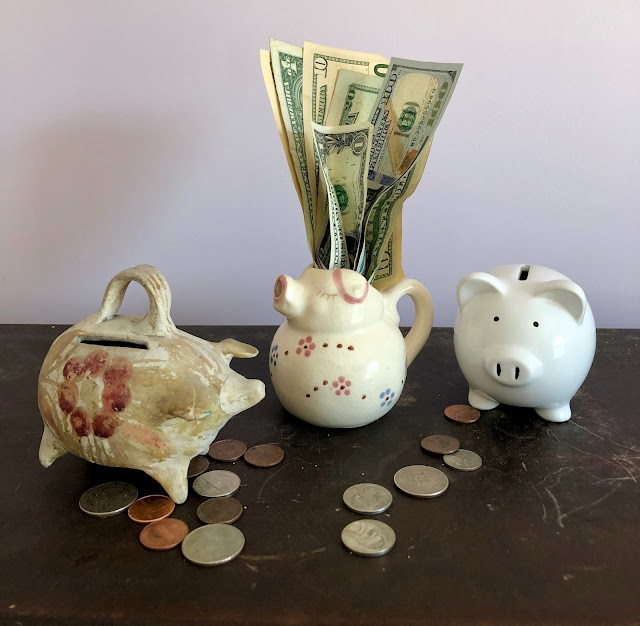12 Ways to Save Money with Minimalism
Minimalism is about more than decluttering. It's much more than a sleek, modern aesthetic. Minimalism will change your entire life.
One of the most significant benefits of minimalism is financial. A minimalist lifestyle can save much more than most people realize. Let's look at some of those areas.
12 minimalist monetary differences
1. Reduced spending on non-essentials
As fun and relaxing as we imagine retail therapy to be, the reality isn't so glamorous. A 2022 survey found that the average American spends over $300 on impulse purchases every month. It adds up to a whopping $3,768 per year in unplanned spending. What could you do with that money instead?
2. Reduced spending on housing
Minimalism often leads us to downsize our living spaces. And the cost of housing, whether rent or mortgage, is a significant portion of most people's budget.
Now some may move from a 2,500 square foot home to a 1,000 square foot condo or apartment, but we don't have to compare such a drastic change. How about looking at a situation where you simply lose one bedroom?
For the sake of comparison, I checked the average rent difference between one-bedroom and two-bedroom apartments in the U.S. It's $336 per month, which works out to $4,032 per year.
3. Reduced utility bills
Obviously, if you live in a smaller space, it takes less energy to heat, cool, and light it.
According to nerdwallet.com, the average residential electricity bill in 2021 was $122 per month. If you reduce that by just 20%, you'll save almost $293 over a year.
4. Reduced furniture and décor costs
Americans spend an average of $196 per month on furnishing their homes. This $2,354 covers everything from bath towels to new chairs and lighting in the dining room, from wallpapering the living room to replacing the washing machine. Some of those are necessities and some fall under the category of "nice to have."
With care, creativity, and a smaller home, these costs might be reduced by as much as 20%, saving $470 per year.
5. Reduced auto costs
According to Kelley Blue Book data, the average price for a new car in April 2023 was $48,275. Since most new cars depreciate 35% in the first three years, you could buy that vehicle for $31,379 slightly used.
But even if you want a new car, you don't have to spend $48,000. There are many excellent cars that cost far less, including the 2023 version of my current vehicle, which sells for just over $21,000. Even if you can afford to buy an expensive car, driving something more moderate makes a strong statement about your values. With savings of between $1,700 and $4,500 per year, it's worth thinking about.
Additionally, every month you keep a paid-off car puts hundreds of dollars in your pocket. At some point an old vehicle costs more to maintain, but until then you can save a lot of money before you have to buy its replacement.
6. Reduced spending on clothes
Minimalism usually includes one's wardrobe. According to financial website The Motley Fool, the average American household spends $1,434 on clothing and shoes each year. They note that this is approximately 23% lower than pre-pandemic levels.
With a minimalist approach, you might cut costs by another 25% and save $358 per year.
7. Reduced food waste
Planning meals, shopping with a list, and avoiding impulse buys at the grocery store are all part of a minimalist lifestyle. But according to eatpallet.com, the average family in the U.S. wastes more than $1,500 worth of food every year. With more care, we could cut waste in half, saving $750 per year.
8. Reduced restaurant meals
My husband and I love eating out, and we're not alone. In 2018, the restaurant guide Zagat found that the average American family ate out 5.9 times per week. In 2023, we're spending more on restaurant food than on groceries. According to the Bureau of Labor Statistics, the cost is about $3,000 a year per household.
What if we cut those 5.9 restaurant meals per week to 4? That's a savings of $966 per year.
9. Reduced gift costs
Minimalists love to give, but we're more likely to choose gifts that require time and attention rather than a trip to the store, and we're careful to avoid giving items that will simply become clutter.
In 2021, American families spent an average of $886 on Christmas gifts alone. A minimalist knows it's possible to make people very happy during the holidays while spending much less. Let's be conservative and posit a savings of $400.
10. Reduced entertainment costs
I enjoy going to the theater, and it's not a cheap entertainment option. But I reduce costs by
- subscribing to only one streaming service
- cutting magazine subscriptions
- borrowing books from the library or buying them used
- choosing to see a handful of movies on the big screen instead of going once or twice a month
Instead, we treated ourselves to three shows this year. They were fabulous productions and we truly enjoyed them.
The average concert ticket price in the U.S. is $108, which is less than the average NFL ticket price of $151. None of that includes parking, refreshments, or merchandise. It would be easy to spend a lot of money, but let's be conservative and say you go to one of those events every couple of months. Go every three months instead and you'd save $216 to $302 every year.
11. Fewer upgrades
Most of us own computers, smart phones, and other devices. While we tend to use our computers as long as possible, the average user replaces his or her smart phone every 18 months, according to theworldcounts.com.
As with a car payment, each additional month you're able to squeeze out of your phone is money you can save or otherwise use. I'm still quite happy with my iPhone 6s, which is over five years old.
12. No credit card debt
In 2011, my husband and I owed more than $12,000 on credit cards. According to the consumer finance company Bankrate, 46% of Americans carry a credit card balance from month to month. This compounds interest charges as well.
The solution is simple in theory but more difficult in practice. Don't charge anything you can't afford to pay off this month. Build an emergency fund so you can pay for unexpected expenses without using credit.
There are estimates that indicate that the average American household pays $1,000 per year in credit card interest and fees. A minimalist lifestyle could let you save that entire $1,000.
Financial freedom
I'm not suggesting that minimalists should give up what they love. By making thoughtful choices, we can stop wasting money and start to fund what we care about.
Contrary to what our culture tells us, cutting back on nonessentials isn't a sacrifice – it's a gift we give ourselves. By my conservative estimates, minimalist choices can save between $13,953 and $16,839 per year. That's money we're free to use for what truly matters to us, whether that's savings and investment, travel, education, extreme generosity, or something else.
That kind of financial freedom is truly life-changing.
Related article: Why It's Good to Be Weird
If you liked this article, you'll love my book, Simple Money: Achieve Financial Peace and Abundance with Minimalism, available on Amazon.*
* This blog is reader-supported. If you buy through my links, I may earn a small commission.







Comments
Post a Comment